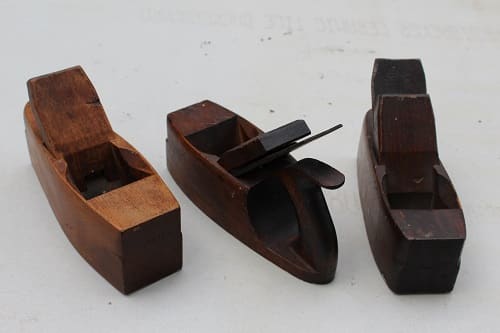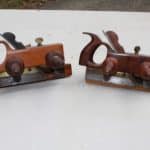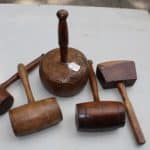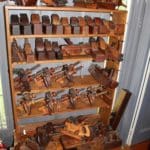Planes Collector
Mark Cerel collects planes, but it’s not a hobby that requires an airplane hangar to warehouse; Mark’s hobby is collecting vintage and antique hand planes and other woodworking tools. A plane is nothing more than a tool for holding a chisel blade in a set position and is used for shaping wood. A tremendous variety of planes were made up until the early 20th century to hold different blades and settings, creating a collectibles market that is rich in both utilitarian and ornate examples of varying value.
It was a chance encounter with an ornate wooden tool he came across at an antique shop in New Hampshire that got Mark started collecting wooden planes. “I was fascinated. After talking to a friend who is into carpentry and doing some research on my own I was able to verify that it was a plow plane (which cuts grooves and dadoes).”
Mark’s collection, on display throughout his home to be seen and enjoyed, consists of over 100 wooden planes from the mostly mid-to-late 1800s, and a ‘fair number’ of other tools, including wooden mallets and levels. “I look for high quality, unique samples, certain makers – I’m pretty eclectic about the types of planes and tools I collect.” What attracts him to these ordinary tools of everyday life is an appreciation for the woods used, the tasks they performed, and the craftsmen who employed them.
Cerel shares that those made out of exotic woods and decorative brass are the most desirable from a collecting standpoint. “These were not casual, everyday tools. The toolmaker wanted to show off their skills and the craftsman wanted to make a statement about being a master craftsman.”
When asked what one item in his collection fascinates him the most, Cerel responds with, “the last thing I purchased because it changes all the time. One plane I particularly like is a bench plane made out of lignum (ironwood). It’s pretty large — twenty-four inches — and I got it up at Brimfield. The wood fascinates me; it’s beautiful. Not just the patina but the wood itself. Usually you find smaller, finishing planes made of lignum.”
At the height of the industry in the second half of the nineteenth century, there were hundreds if not thousands of individual toolmakers; many concentrated in the northeasterly portion of the United States. Some of the more desirable, from a collecting standpoint, include J. Kellogg (Amherst, MA), J. Denison (CT), Greenfield Tool Co. (MA), Auburn Tool Co. (NY) and Sandusky Tool Co. (OH). Good examples of these makers and many others can be found at a moderate price: $50-150. “The ‘holy grail’ of course is a Nicholson or Chelor plane which can be priced in the thousands of dollars.”
Cerel encourages new collectors to do their homework and look for the marks that tell of the tool’s history. “The manufacturers mark is impressed in the wood and there are books you can get that will help guide you. Also look for an owner’s mark. These tools were expensive so the owner wanted them to be identified. The metal blade itself may have been acquired from another manufacturer who would frequently have its own mark on it as well.”
By the early 20th century, metal planes (transition tools) took over and production of wooden planes for utilitarian use ceased to be made but not forgotten, getting a new life in the appreciation of a new generation of collectors.













Related posts: